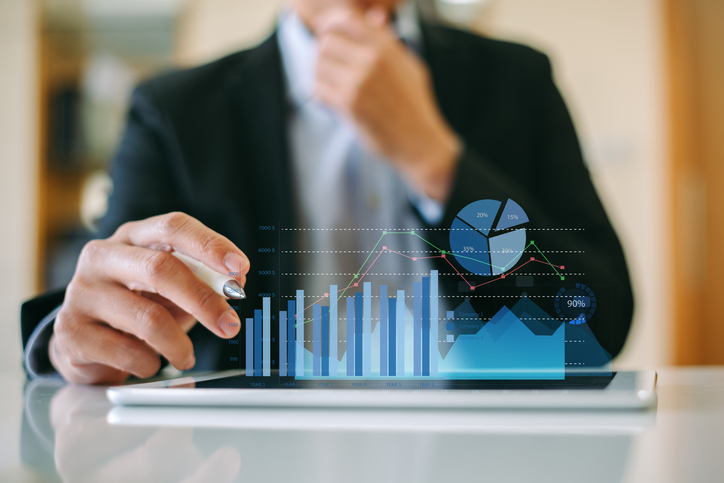Economists Cast Their Predictions For 2024
This is the time of year – early in the first quarter – when economists offer their forecasts for the coming months.
They are not seers, and President Harry Truman was no fan of theirs. He once offered a blunt assessment of them: “Give me a one-handed economist,” the outspoken president once said. “All my economists say, ‘on one hand, then, on the other.’”
Truman was joking, of course. But economic theory is complex, and analyzing it is no joke. The economists can go to extremes.
Alan Greenspan, who was chairman of the Federal Reserve Board from 1987 until his retirement in 2006 – and was one of the best-know of the Fed’s board chairmen – used to study the sale of second-hand automobile tires in making his analysis of the U.S. economy. Greenspan figured that the more used tires sold, the more Americans had to keep their rusty clunkers on the road.
This year, there’s no talk of used tires, but there is plenty of talk from economists about where things are headed. The gabfest was kicked off recently by the Melville office of JP Morgan Chase, which issued a lengthy report warning that, because of still high food prices and some other items, business leaders and consumers are “grappling with choppy financial waters” and that “some business leaders “fear recession looms.”
JP Morgan Chase said in its annual Business Leaders Outlook that it surveyed 1,500 midsized businesses and found that only 19 percent expressed optimism about the economy looking ahead. The bank said that was the lowest percentage recorded in 12 years of survey data, and down 75 percent from a year ago.
But Long Island economists see a somewhat brighter picture.
“Growth here is a little bit lower than it was previously, but it is higher than in many other states,” said Richard Vogel, dean of the school of business at Farmingdale State College. “I tend to think that growth will be a little slower this year, but we will continue to grow.”
Economic growth on Long Island, Vogel said, should be about 2 percent in 2024.
Long Island’s unemployment rate is a remarkably low 3 percent, what economists generally call full employment. Prices at the gas pumps have fallen to just a little above $3 for regular across the Island, giving consumers more spending money.
“Overall, people are better off,” Vogel said.
There are reasons to be optimistic this year, Vogel and other economists say. Overall inflation, which has soared to four-decade highs in June 2022, has dropped dramatically. Consumer prices rose by just 1.3 percent year-over-year this past fall, down from the alarming 9.1 percent recorded in June 2022.
But, Vogel and other economists say, housing remains a persistent problem on Long Island. Many younger people are priced out of the Island’s high home price market and are forced to leave the area.
“This causes a problem for businesses trying to retain people,” Vogel said.
Martin Melkonian, an economics professor at Hofstra University, said, “You’re hoping for a good year, but I am a little cautious.”
The supply chain has been disrupted, most recently because of hostile action against Western ships by Houthi rebels, in the Red Sea. Many ships are avoiding the area, creating long delays in the shipment of goods. The U.S. relation with China continues to worsen, threatening higher prices for Chinese goods.
But while in the case of food, prices remain high at the supermarket, the Federal Reserve has signaled that it plans to halt its aggressive interest rate hikes. The Fed is even considering rate cuts in 2024, starting in March and May.
Melkonian believes Long Island will do a bit better than the rest of the country for two reasons: there is a significant amount of wealth on the Island, and the region’s economy is centered, to a great extent, by the explosive healthcare industry. Long Island is home to Northwell, the largest provider of healthcare services in the state.
There is, Melkonian said, much dissatisfaction about the two possible candidates for president: Donald Trump and President Joe Biden. That tends to create uncertainty in the stock market going forward, but at the moment, the market is robust. The broad Standard & Poor’s 500 is currently experiencing its longest winning streak since 2004, and the tech-heavy Nasdaq has also scored some impressive gains.
Martin Cantor, director of the Long Island Center for Socio-Economic Policy and a former Suffolk County Economic Development Commissioner, said he does not see any recession on the horizon.
“This is the most unusual economy I’ve ever seen,” Cantor said. “We have some inflation but Gross Domestic Product is going pretty well and employment is going well. We’re creating jobs.”
The approximately 3 percent unemployment rate is about the lowest in several decades. Layoffs have remained consistently low, at about 200,000 per month, suggesting employers are reluctant to let workers go.
“But food prices are still higher,” Canto said. “That’s a problem we have.”
The migrant crises is also a problem, Cantor said. New York State funds being used to care for migrants arriving here from the Tex-Mex border, he said, could instead to be used for tax cuts.
Nonetheless, Cantor said. “The economy will not get worse” in 2024.
Where Things Are Headed
The gabfest was kicked off by JPMorgan Chase, which issued its annual Business Leaders Outlook Pulse survey for 2024, JP Morgan Chase said 817 respondents completed its survey late in 2023. The bank said “After more than three years of economic turbulence, mid sized business leaders appear measured in their outlook for 2024. The bank said also that “more than a third of leaders view prospects for the global and U.S. economies as neutral.” Attitudes about the national economy are nearly evenly split between optimism (31%), pessimism (34%) and neutrality (36%).
“The responses could suggest executives are positioning their organizations for a range of economic environments,” the bank said. “Uncertainty has been a hallmark of the markets in the post-pandemic era.” And, it said, “Lingering challenges around inflation and hiring remain top of the mind. At the end of 2023, 40% of midsized business leaders said they expect a recession in the coming year, compared to 66% at the start of 2023.”
JPMorgan said that business leaders are “increasingly exploring how they might use artificial intelligence. It said nearly half (45%) are using or considering AI tools, an 8-point increase since 2023. Finally, the bank said, business leaders “remain bullish on growth,” with more than half planning to introduce new products or services in the next 12 months and more than one-third planning expansion into new markets.




























